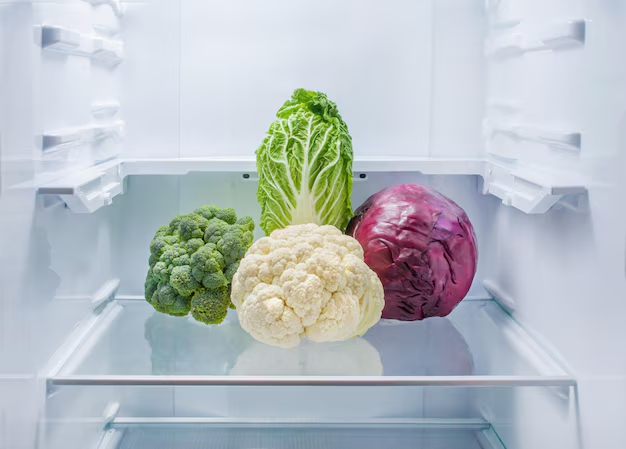How Fresh Can It Stay? Exploring Broccoli’s Lifespan in Your Fridge
When you pick up that vibrant, green head of broccoli from the grocery store or farmer's market, you're likely planning on making it a part of your healthy meals. Yet, life happens, and sometimes vibrant veggies end up languishing in the crisper drawer longer than anticipated. A common question arises among conscientious home cooks: "How long does fresh broccoli remain good in the refrigerator?" This guide will help you navigate the ins and outs of broccoli storage, ensuring your produce stays fresh and delicious for as long as possible.
Understanding Broccoli's Shelf Life
Broccoli is a favorite among those seeking to eat a balanced, nutritious diet. Its florets and stalks pack a punch with nutrients like vitamin C, fiber, and antioxidants. To get the most out of broccoli, it’s essential to understand its storage life and how to extend it.
Typical Lifespan in the Refrigerator
Under usual refrigeration conditions, unwashed and raw broccoli can last anywhere from 3 to 5 days. This timeframe is a general estimate — broccoli might start showing signs of spoilage before or after this period depending on how fresh it was when you purchased it and how it's stored.
- Factors affecting longevity: Broccoli's shelf life hinges on factors such as moisture levels, temperature consistency in the fridge, and whether it’s stored with damaged or rotting produce.
Signs of Spoilage
Detecting spoilage early can save you from adding spoiled veggies to your meal. Look out for:
- Color changes: Broccoli should be vibrant green; yellowing or browning indicates aging.
- Odor: A bad or sour smell means it's time to toss it.
- Texture: Wilted, shriveled, or limp broccoli is past its prime.
- Mold: Visible mold or excessive moisture is a clear sign of spoilage.
Tips for Proper Broccoli Storage
Ensuring your broccoli remains in peak condition requires more than just placing it in the fridge. Here are some pro tips to maximize freshness:
Moisture Management
- Do not wash before storage: Wait until you’re ready to use it. Moisture trapped in the florets can accelerate spoilage.
- Use a dry towel: Wrap stalks loosely in a dry towel or paper towel before putting them in a plastic bag, which can help absorb excess moisture.
Temperature Considerations
- Optimal fridge temperature: Keep your refrigerator set between 32°F to 40°F (0°C to 4°C) for best results. Too much fluctuation speeds up decomposition.
The Right Container
- Breathability is key: Use perforated plastic bags or containers to store broccoli, allowing for air circulation while reducing exposure to too much drying air.
Location Matters
- Store in the crisper drawer: This section of the fridge is specifically designed to maintain humidity, making it ideal for broccoli.
Creative Uses to Extend Broccoli’s Usefulness
If you find yourself with an abundance of broccoli close to its end, don't fret. Broccoli can be adapted into different preparations that might extend its usefulness beyond its raw state.
Cooking and Freezing
- Blanching: Boil broccoli for 2-3 minutes, then quickly submerge in ice water. This process helps retain its color and nutrients if you decide to freeze it.
- Soup starter: Cooked broccoli can be a base for comforting soups. Combine with other vegetables or blend it for a creamy texture.
Fermentation and Pickling
- Fermented broccoli: A growing trend involves fermenting vegetables for their probiotic benefits. Consider fermenting sliced broccoli stems—this process often extends the shelf life significantly while adding tangy flavors.
- Pickling: Create pickled broccoli with vinegar, spices, and a splash of sugar. Refrigerate and use it as a crunchy topping for sandwiches or salads.
Practical Summary: Keeping Broccoli Fresh 🥦
- Storage Time: Raw, refrigerated broccoli lasts 3-5 days.
- Spoilage Signs: Look for yellowing, bad odors, limpness, and mold.
- Storage Tips:
- 🌡️ Keep the fridge between 32°F to 40°F.
- 🧺 Let it breathe in perforated bags.
- 🕵️♂️ Inspect regularly for freshness.
💡 Pro Tip: Blanch and freeze broccoli for longer storage!
Understanding Broccoli's Nutritional and Culinary Contribution
While understanding storage is important, it's worth noting why maintaining broccoli’s freshness is so beneficial.
Nutritional Value
Broccoli is a powerhouse of essential nutrients:
- Rich in vitamins: High in vitamins C, K, and A, it supports immune function, bone health, and vision.
- Fiber content: Aids digestive health and contributes to feelings of fullness, which might assist with weight management.
- Antioxidants: Offers sulfur-containing compounds linked to reduced inflammation.
Versatile in the Kitchen
Broccoli's adaptability means you can use it in numerous dishes, providing both flavor and nutritional benefits.
- Salads and slaws: Enjoy raw or lightly blanched, adding crunch and color.
- Stir-fries: Complementing proteins like chicken, beef, or tofu, broccoli absorbs savory sauces well.
- Roasting: Toss with olive oil and your choice of spices for caramelized edges and a nutty flavor.
Wrapping It Up: Broccoli’s Refrigerator Journey
Maintaining broccoli's freshness involves understanding its storage needs and spotting spoilage signs in advance. Equipping yourself with the right tools and techniques, like optimal temperature settings and proper storage methods, can transform your kitchen habits, ensuring you make the most out of your greens. Remember, adapting recipes and preparation methods can also integrate broccoli into your meals, even if it's nearing the end of its refrigerator life.
By taking these steps, not only do you minimize food waste, but you also ensure that meals are both delicious and nutritious, benefiting your health and the environment. Enjoy your culinary adventures with broccoli, knowing you're equipped to store and use it wisely. 🥦
